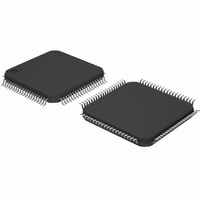DP83849CVS/NOPB National Semiconductor, DP83849CVS/NOPB Datasheet - Page 40

DP83849CVS/NOPB
Manufacturer Part Number
DP83849CVS/NOPB
Description
IC TXRX ETHERNET PHY DUAL 80TQFP
Manufacturer
National Semiconductor
Type
Transceiverr
Specifications of DP83849CVS/NOPB
Number Of Drivers/receivers
2/2
Protocol
Ethernet
Voltage - Supply
3 V ~ 3.6 V
Mounting Type
Surface Mount
Package / Case
80-TQFP, 80-VQFP
Data Rate
100Mbps
Supply Voltage Range
3V To 3.6V
Logic Case Style
TQFP
No. Of Pins
80
Operating Temperature Range
0°C To +70°C
Msl
MSL 3 - 168 Hours
Filter Terminals
SMD
Rohs Compliant
Yes
Data Rate Max
10Mbps
For Use With
DP83849CVS-EVK - BOARD EVALUATION DP83849CVS
Lead Free Status / RoHS Status
Lead free / RoHS Compliant
Other names
*DP83849CVS
*DP83849CVS/NOPB
DP83849CVS
*DP83849CVS/NOPB
DP83849CVS
Available stocks
Company
Part Number
Manufacturer
Quantity
Price
Company:
Part Number:
DP83849CVS/NOPB
Manufacturer:
NS
Quantity:
618
Company:
Part Number:
DP83849CVS/NOPB
Manufacturer:
Texas Instruments
Quantity:
10 000
www.national.com
4.3.3 Collision Detection and SQE
When in Half Duplex, a 10BASE-T collision is detected
when the receive and transmit channels are active simulta-
neously. Collisions are reported by the COL signal on the
MII. Collisions are also reported when a jabber condition is
detected.
The COL signal remains set for the duration of the collision.
If the PHY is receiving when a collision is detected it is
reported immediately (through the COL pin).
When heartbeat is enabled, approximately 1 s after the
transmission of each packet, a Signal Quality Error (SQE)
signal of approximately 10-bit times is generated to indi-
cate successful transmission. SQE is reported as a pulse
on the COL signal of the MII.
The SQE test is inhibited when the PHY is set in full duplex
mode. SQE can also be inhibited by setting the
HEARTBEAT_DIS bit in the 10BTSCR register.
4.3.4 Carrier Sense
Carrier Sense (CRS) may be asserted due to receive activ-
ity once valid data is detected via the squelch function.
For 10 Mb/s Half Duplex operation, CRS is asserted during
either packet transmission or reception.
For 10 Mb/s Full Duplex operation, CRS is asserted only
during receive activity.
CRS is deasserted following an end of packet.
4.3.5 Normal Link Pulse Detection/Generation
The link pulse generator produces pulses as defined in the
IEEE 802.3 10BASE-T standard. Each link pulse is nomi-
nally 100 ns in duration and transmitted every 16 ms in the
absence of transmit data.
Link pulses are used to check the integrity of the connec-
tion with the remote end. If valid link pulses are not
received, the link detector disables the 10BASE-T twisted
pair transmitter, receiver and collision detection functions.
When
(FORCE_LINK_10 of the 10BTSCR register), a good link is
forced and the 10BASE-T transceiver will operate regard-
less of the presence of link pulses.
4.3.6 Jabber Function
The jabber function monitors the DP83849I's output and
disables the transmitter if it attempts to transmit a packet of
longer than legal size. A jabber timer monitors the transmit-
ter and disables the transmission if the transmitter is active
for approximately 85 ms.
the
link
integrity
function
is
disabled
40
Once disabled by the Jabber function, the transmitter stays
disabled for the entire time that the ENDEC module's inter-
nal transmit enable is asserted. This signal has to be de-
asserted for approximately 500 ms (the “unjab” time)
before the Jabber function re-enables the transmit outputs.
The Jabber function is only relevant in 10BASE-T mode.
4.3.7 Automatic Link Polarity Detection and Correction
The DP83849I's 10BASE-T transceiver module incorpo-
rates an automatic link polarity detection circuit. When
three consecutive inverted link pulses are received, bad
polarity is reported.
A polarity reversal can be caused by a wiring error at either
end of the cable, usually at the Main Distribution Frame
(MDF) or patch panel in the wiring closet.
The bad polarity condition is latched in the 10BTSCR regis-
ter. The DP83849I's 10BASE-T transceiver module cor-
rects for this error internally and will continue to decode
received data correctly. This eliminates the need to correct
the wiring error immediately.
4.3.8 Transmit and Receive Filtering
External 10BASE-T filters are not required when using the
DP83849I, as the required signal conditioning is integrated
into the device.
Only isolation transformers and impedance matching resis-
tors are required for the 10BASE-T transmit and receive
interface. The internal transmit filtering ensures that all the
harmonics in the transmit signal are attenuated by at least
30 dB.
4.3.9 Transmitter
The encoder begins operation when the Transmit Enable
input (TX_EN) goes high and converts NRZ data to pre-
emphasized Manchester data for the transceiver. For the
duration of TX_EN, the serialized Transmit Data (TXD) is
encoded for the transmit-driver pair (PMD Output Pair).
TXD must be valid on the rising edge of Transmit Clock
(TX_CLK). Transmission ends when TX_EN deasserts.
The last transition is always positive; it occurs at the center
of the bit cell if the last bit is a one, or at the end of the bit
cell if the last bit is a zero.
4.3.10 Receiver
The decoder detects the end of a frame when no additional
mid-bit transitions are detected. Within one and a half bit
times after the last bit, carrier sense is de-asserted.
Receive clock stays active for five more bit times after CRS
goes low, to guarantee the receive timings of the controller.











